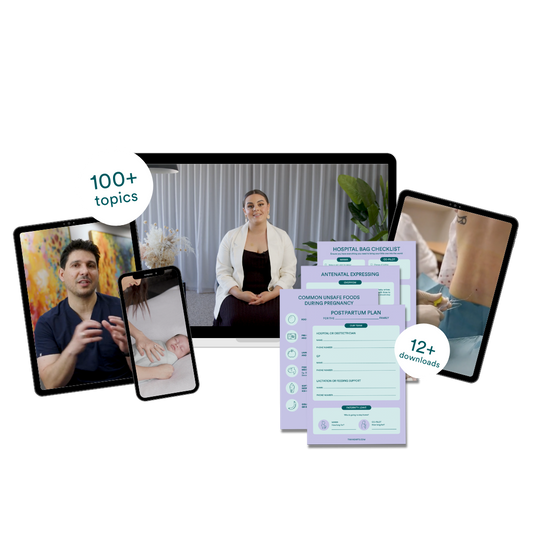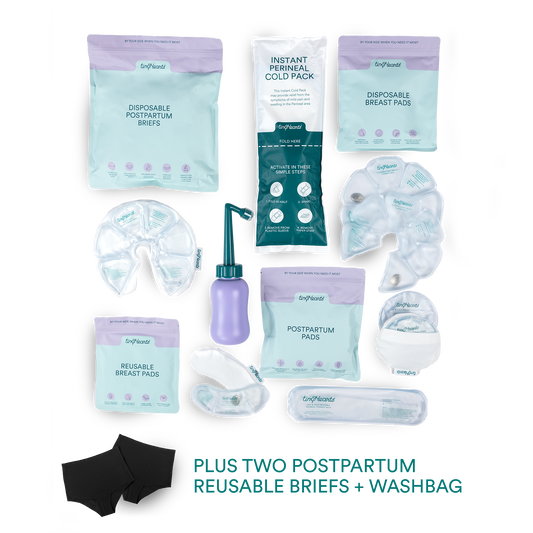
Over 28% of Australian women have a caesarean section - but so many women have no idea what to expect or how to recover from it. So, we're here today to talk about the types of caesareans, what to expect in surgery and how to recover:
Types of Caesareans
Elective:
These are pre-booked in advance and are due to either the request of the Mother, or existing health concerns that mean a vaginal birth could be harmful to mum and bub. An elective caesar, however, can prevent complications that may have otherwise occurred through vaginal birth.
Emergency:
Emergency caesareans can occur for a number of reasons such as bub's wellbeing, your labour not progressing, maternal complications like severe bleeding or pre-eclampsia or if there is a life-threatening emergency to you or your baby.
Types of Caesarean Cuts
A Lower Segment Caesarean Section:
This is the most common type of caesarean. If you have a lower segment caesarean section, an obstetrician will make a horizontal cut across the lower part of the uterus, generally along the bikini line.
The best thing about this is that this type of cut usually heals well and has a smaller chance of causing problems in future pregnancies - phew!
A Classical Caesarean Section:
This type of caesarean is less common and is only ever used in emergencies. A classical caesarean section is when an obstetrician makes a vertical cut on the uterus. If your bub is premature or lying sideways or if you have a very low lying placenta - this is when a classical caesarean section may be needed.
Unfortunately, this type of cut can increase the risk of problems in future pregnancies and births because it increases the chance of a tear to your uterus - ouch!

Lower Segment Caesarean Section and Classical Caesarean Section
The Surgery
A caesarean section usually takes around half an hour to an hour.
Along with your support person, you'll be accompanied in the theatre by your obstetrician, an anaesthetist, theatre nurses and most likely a paediatrician and a midwife. The only time your support person would be asked to leave the room is if you need a general anaesthetic or there are serious medical complications.
Just before surgery begins, you will be given an anaesthetic, so you don't feel any pain during the birth. Depending on the type of caesarean and situation, you will be either given a spinal anaesthetic or an epidural. These types of pain relief allow you to be awake and present. You may feel tugging and pulling sensations as your bub is pulled out - but no pain.
The only time you'll receive a general anaesthetic is if you're unable to have a spinal anaesthetic or epidural. You may also receive this if your bub needs to be born very quickly.
Generally, a drape will be placed over your chest area so that you and your support person can't see the surgery. However, clear drapes are becoming increasingly common which allow parents to watch the procedure - so if this is something you're interested in, make sure you discuss this with your doctor before go time!
Once the anaesthetic is working, your doctor will begin making the cuts in your stomach and uterus. They will be around 10 cm long. Your bub will then be lifted out through the cut. Sometimes, your doctor may use forceps to help lift your baby's head out, so don't be concerned if this occurs. After this, you will be able to get your first look of bub - congratulations!
The umbilical cord will be cut, and your placenta will be removed promptly after while the doctors and midwives do the usual checks of your little one. If everything is okay, you will have immediate skin-to-skin contact. If you can't hold your bub in the operating theatre, your support person will most likely be able to hold your bub instead.
Your doctor will then stitch the layers of uterus, muscle, fat and skin in your stomach back together and will recommend injection or medication via a drip to make your uterus contract and to reduce bleeding.
After The Surgery
Once you're stitched up, midwives and nurses will take care of you in the recovery room until you're ready to move into the maternity ward. You will most likely have your bub stay with you during this time.
In the recovery room midwives and nurses will do the following:
- Help you to breastfeed your baby for the first time (if you're breastfeeding)
- Check your blood pressure, your wound and the amount of vaginal bleeding for the first few hours
- Monitor your drip and urinary catheter (this is often removed after the first 24 hours)
- Help you shower after the first 12 hours
If you feel discomfort, this is totally normal, especially when you move. Make sure you keep the midwives updated with how you're feeling as it's best to stay on top of pain. You are generally allowed to take strong pain-relieving tablets.
Recovery
While you may not know whether or not you're having a caesarean birth - it's essential to prepare for the possibility and to plan practical things for when you're at home recovering:
Driving:
You are not able to jump behind the wheel until the doctor gives you the a-okay. This is when your partner or friends can jump in and help to say thank you for the 9 months of designated driving you did. Plus! You might not be covered by your car insurance if a bingle was to happen on the road before you had received clearance to drive.
Housework:
It is time to put the vacuum away! You should not be lifting anything heavier than your bub for several weeks. We're talking no grocery shopping, laundry or cleaning (but I mean, are you really mad about this?).
Accepting Help:
It is okay to take help and please don't be afraid to ask for it - you will need it and deserve it!
People often forget that a caesarean birth is a major surgical operation to the abdomen and uterus. So, take your time, rest, recover and enjoy this special time with your beautiful family.








